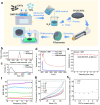3D Printing of Periodic Porous Metamaterials for Tunable Electromagnetic Shielding Across Broad Frequencies
- PMID: 39225896
- PMCID: PMC11371985
- DOI: 10.1007/s40820-024-01502-5
3D Printing of Periodic Porous Metamaterials for Tunable Electromagnetic Shielding Across Broad Frequencies
Abstract
The new-generation electronic components require a balance between electromagnetic interference shielding efficiency and open structure factors such as ventilation and heat dissipation. In addition, realizing the tunable shielding of porous shields over a wide range of wavelengths is even more challenging. In this study, the well-prepared thermoplastic polyurethane/carbon nanotubes composites were used to fabricate the novel periodic porous flexible metamaterials using fused deposition modeling 3D printing. Particularly, the investigation focuses on optimization of pore geometry, size, dislocation configuration and material thickness, thus establishing a clear correlation between structural parameters and shielding property. Both experimental and simulation results have validated the superior shielding performance of hexagon derived honeycomb structure over other designs, and proposed the failure shielding size (Df ≈λ/8 - λ/5) and critical inclined angle (θf ≈43° - 48°), which could be used as new benchmarks for tunable electromagnetic shielding. In addition, the proper regulation of the material thickness could remarkably enhance the maximum shielding capability (85 - 95 dB) and absorption coefficient A (over 0.83). The final innovative design of the porous shielding box also exhibits good shielding effectiveness across a broad frequency range (over 2.4 GHz), opening up novel pathways for individualized and diversified shielding solutions.
Keywords: 3D printing; Honeycomb pore structure; Periodic porous metamaterials; Polymeric component; Tunable electromagnetic shielding.
© 2024. The Author(s).
Conflict of interest statement
The authors declare no conflict of interest. They have no known competing financial interests or personal relationships that could have appeared to influence the work reported in this paper.
Figures







References
-
- A. Iqbal, P. Sambyal, C. Koo, Electromagnetic interference shielding: 2D MXenes for electromagnetic shielding: A review. Adv. Funct. Mater. 30, 2070307 (2020). 10.1002/adfm.202070307
-
- F. Shahzad, M. Alhabeb, C. Hatter, B. Anasori, S. Man Hong et al., Electromagnetic interference shielding with 2D transition metal carbides (MXenes). Science 353, 1137–1140 (2016). 10.1126/science.aag2421 - PubMed
-
- Q. Wei, S. Pei, X. Qian, H. Liu, Z. Liu et al., Superhigh electromagnetic interference shielding of ultrathin aligned pristine graphene nanosheets film. Adv. Mater. 32, 1907411 (2020). 10.1002/adma.201907411 - PubMed
-
- S.K. Srivastava, K. Manna, Recent advancements in the electromagnetic interference shielding performance of nanostructured materials and their nanocomposites: A review. J. Mater. Chem. A 10, 7431–7496 (2022). 10.1039/d1ta09522f
-
- B. Wei, L. Zhang, S. Yang, Polymer composites with expanded graphite network with superior thermal conductivity and electromagnetic interference shielding performance. Chem. Eng. J. 404, 126437 (2021). 10.1016/j.cej.2020.126437
LinkOut - more resources
Full Text Sources
Miscellaneous
